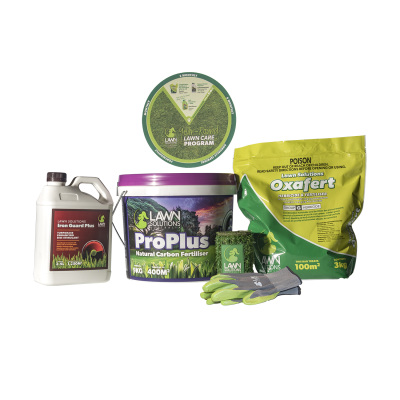What’s the best way to prepare your soil for new turf?
Successful establishment of all lawn types relies on proper soil preparation. Preparation for establishing a lawn usually begins after construction activities have finished, or before topsoil has been introduced.
Skip to: Remove existing lawn/weeds, Preparing your soil, Test your soils pH, Level your area, Lawn starter fertiliser, Lay your new lawn.

Without preparing your soil properly, your lawn can suffer from poor soil drainage, compaction, pH or fertility problems that could have otherwise been simply prevented.
Remove the existing lawn/ground covers
Kill off any existing vegetation using glyphosate or a similar non-selective herbicide like RoundUp. You may need 2 applications to ensure all existing vegetation is completely eradicated.
Hoe in and turn over the existing base and remove any excess vegetation that has been sprayed out.

Preparing your soil
Upon completion of a new build it is recommended to strip the top layer of your soil by around 150mm (six inches). This will ensure the removal of any debris, clay or poor growing medium.
Depending on your existing base, add in any soil required to make sure you have the appropriate base for turf. An 80/20 sandy loam or a turf underlay mix is preferred. We recommend bringing in at least 80-100mm of quality soil. If you have a clay base you will need to de-compact this, use a clay breaker like gypsum and add sand soil. For more information on how to amend a clay base for turf, check out our blog here. If your base is already sandy, look at mixing in some organics to boost nutrients.

Time for your new lawn?
Get Free Turf Quotes
Test your soils pH
Conduct a pH test on your soil using a pH testing kit. You want to have a pH between 5.5 and 7. If it is either side of this, your pH can be adjusted with some treatment and before your turf is installed is the best time to act. Check out our article for rectifying pH levels here.

Level your area
Finally, it’s time to get your levels correct. When looking to lay turf flush with an edge, keep your soil about 30-40mm below this height. This will allow for the thickness of the turf. Smooth out the rest of your soil, remembering to factor in drainage as you do so. The grade of your lawn area should slope enough to allow surface water to drain away quickly.

Lawn starter fertiliser
Lawn starter fertilisers like Lawn Launcher can be spread out onto the soil before the new turf is laid to help give the lawn an extra boost during its establishment.*When installing TifTuf Hybrid Bermuda in summer we don’t recommend using a starter fertiliser as it is a fast-growing grass.
Lay your new lawn
Now there’s only one thing left to do! Lay your new lawn! To order your new lawn, get in contact with your local Lawn Solutions Australia member for the best varieties and the highest quality turf. You can see who your local Lawn Solutions members out near you here.

Time for your new lawn?
Get Free Turf Quotes
Check with your local LSA supplier if you are unsure if your soil is suitable or if you have any other questions on specific soil information for your area.


